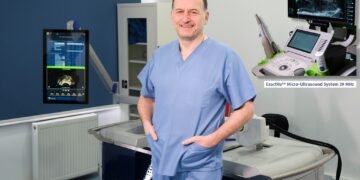The development of uterine fibroids is most commonly linked to hormonal changes occurring in a woman’s body — particularly an increase in estrogen levels. This condition is most often observed in women of reproductive age.
After menopause, due to the natural decrease in estrogen, uterine fibroids may shrink or even disappear without any treatment.
Possible Causes Include:
- Genetic predisposition
- Hormonal imbalances
- Adenomyosis
- Inflammatory diseases of the reproductive organs
- Metabolic disorders (including diabetes)
- Chronic systemic diseases
- Obesity and sedentary lifestyle
- Chronic stress
- Use of intrauterine contraceptive devices
Uterine fibroids can also develop as a result of abortions or anorgasmia (sexual dissatisfaction).
Uterine Fibroids – Main Symptoms
In 50% of cases, uterine fibroids are asymptomatic. This is typically the case with small, single or multiple intramural and subserosal fibroids.
Larger fibroids usually cause symptoms. The most typical one is menorrhagia (heavy menstrual bleeding), along with pain and a feeling of heaviness in the lower abdomen. Menorrhagia is mostly characteristic of submucosal fibroids.
As fibroids grow, menstruation becomes increasingly heavy and prolonged, which often leads to anemia. Pain and heaviness in the lower abdomen are more often associated with subserosal and intramural fibroids.
Pain usually occurs during menstruation and is cramping in nature. It can be sharp, especially if the fibroid is twisted at its stalk (a relatively rare complication). Rare symptoms of uterine fibroids include infertility and functional disorders of neighboring organs.
Treatment of Uterine Fibroids
The treatment strategy depends on the size and number of fibroids, as well as the severity and intensity of symptoms. For small, asymptomatic fibroids, a watch-and-wait approach is often taken, especially if the woman is nearing menopause.
Surgical Treatment
Historically, hysterectomy (removal of the uterus) was the only method for treating fibroids. Today, this approach is used less frequently due to the availability of modern, minimally invasive and highly effective methods.
Endoscopic Methods
Fibroids can be treated via endoscopic procedures. Subserosal fibroids are removed via laparoscopy, while hysteroscopy is used to remove submucosal fibroids.
Embolization
Uterine artery embolization is another method used to treat fibroids. This procedure involves blocking the uterine arteries to stop blood flow to the fibroid, causing it to shrink over time.
During the procedure, a catheter is inserted through the femoral artery and guided into the uterine artery. A special substance is injected to block the targeted artery, cutting off blood supply to the fibroid.
This is considered a minimally invasive technique that does not require general anesthesia or hospitalization.
FUS Ablation
FUS ablation (Focused Ultrasound Surgery) is a minimally invasive and uterus-preserving method. It uses high-intensity focused ultrasound waves to thermally damage (destroy) the fibroid tissue.
This method is mainly used for treating fibromyomas (which make up about 70% of fibroids), as the ultrasound targets the connective tissue within the fibroid. The energy accumulates in this tissue, causing thermal necrosis.
Open Surgery & Hysterectomy
Depending on the location and type of fibroids, open surgical procedures (laparotomy) may also be required. Hysterectomy — the complete removal of the uterus — is performed only when less invasive methods are not an option.
In all cases, the choice of treatment and approach depends on the patient’s condition and the specific characteristics of the fibroids, and is determined by a medical specialist.
“Kharazishvili Robotic Center” offers fibroid treatment in accordance with international medical standards.









